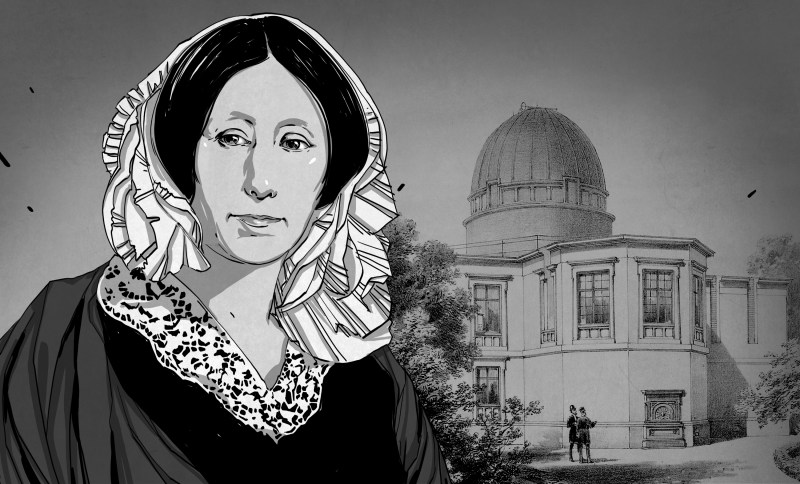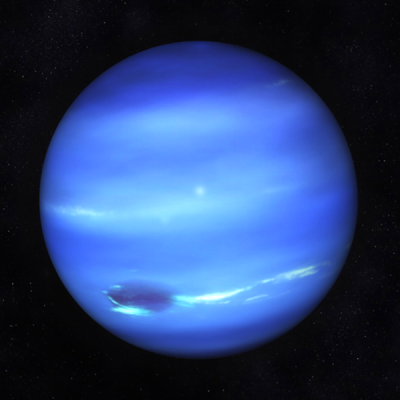Science, as a concept, is relatively new. Benjamin Franklin wasn’t a scientist probing the mysteries of amber and wool and electricity and ‘air baths’; he was a natural philosopher. Antonie van Leeuwenhoek was simply a man with a proclivity towards creating new and novel instruments. Robert Hooke was a naturalist and polymath, and Newton was simply a ‘man of science’. None of these men were ever called ‘scientists’ in their time; the term hadn’t even been coined yet.
The word ‘scientist’ wouldn’t come into vogue until the 1830s. The word itself was created by William Whewell, reviewing The Connexion of the Physical Sciences by Mary Somerville. The term used at the time, ‘a man of science’, didn’t apply to Mrs. Somerville, and, truth be told, the men of science of the day each filled a particular niche; Faraday was interested in electricity, Darwin was a naturalist. Mary Somerville was a woman and an interdisciplinarian, and the word ‘scientist’ was created for her.
Discovering Neptune, and Earth
The history of physics is in part the history of astronomy. Following the publication of Newton’s Principia, the observations of Kepler and Brahe, men of science had become very, very good at measuring and tracking the motions of the planets. There was a lack of a truly predictive quality to this science, though; what discoveries could be made with this new-found knowledge?
This opportunity would arise in the late 1700s with the discovery of Uranus by William Herschel. The first new planet, along with the discovery of Ceres and other main belt asteroids in the 1800s, would provide astronomers with a wealth of data to catalog, new planets to find, and new discoveries to be made.
In 1831, Somerville would publish Mechanism of the Heavens, a 700-page tome describing the entirety of celestial mechanics. In this book, Somerville described the pull of gravity on the surface of the sun and planets, the pull of gravity on Earth, determined by the period of a pendulum, and a solution to a problem that stumped Kepler, finding the true anomaly of an orbit, or the angle between the direction of the periapsis and the current position of the celestial body.
Somerville’s work also concerned the perturbations of the planets due to the gravitational effects of Jupiter and Saturn, and suggested the orbit of the then newly-discovered Uranus may be influenced by another rogue planet. This influenced John Couch Adams to calculate the position of such a planet, leading to the discovery of Neptune. Although the discovery of Neptune is muddled in a controversy, the person who developed the tools to do so was Mary Somerville.
But Somerville did not concern herself solely with the motions of the heavens. Arguably, her most influential achievement was a textbook, Physical Geography. This book described geography as mountains, lakes, and rivers, but also discussed plant and animal inhabitants and their geographical distribution across the planet. In short, Somerville’s work described the modern concept of physical geography and was used as the standard textbook for the field for decades after her death.
Replication Studies Are Great, Even If They’re Wrong
Somerville didn’t always get it right, however. In 1813, a Professor Morichini in Rome discovered that steel, exposed to the violet rays of the solar spectrum, became magnetic. This turns out not to be the way the world works, but because magnetism was so poorly understood — this was still several years before Ørsted noticed a compass needle twitching when placed near an electric current — and the fact there was apparently a connection between light and magnetism, no one knew if this effect was real.
Several scientists of the time attempted a replication of Morichini’s experiment but failed in their replication of the experiment. Somerville somehow succeeded. Her paper was presented on her behalf to the Royal Society in 1826 by her husband William Somerville — the Royal Society was still a men’s club. Mary presented the first positive replication of Morichini’s findings. In response, Sir David Brewster, inventor of the kaleidoscope and stereoscope, wrote Somerville was, ‘certainly the most extraordinary woman in Europe’.
We don’t know what caused the effect in Somerville’s experiment. Faraday later suggested that heating the metal in the presence of the Earth’s magnetic field could have magnetized it. At the time, measurements of magnetism were more qualitative than quantitive. At any rate, Somerville was probably responsible for prolonging interest in photomagnetism, wrongly, for fifteen years or so. You can’t win them all.
The Legacy of Mary Somerville
Along with Caroline Herschel, Somerville became the first women inducted into the Royal Astronomical Society. After the publication of Connexion, she was granted a civil pension by the Crown of £200 per year in recognition to her contributions to science. There is a crater on the moon, an asteroid, and a college at Oxford bearing her name.
However, perhaps her greatest contribution to society was her endorsement of John Stuart Mill’s petition for female suffrage. Mill asked Somerville to sign the petition after her autobiography described the challenges she faced in obtaining an education as a young girl. Where the boys learned Latin, the girls were only allowed to study the Bible. Where the boys learned Greek, the girls learned needlework and other domestic duties. Despite this, Somerville rose to prominence in such a way that she alone can be called the first scientist.

















Great read! This is the first I’ve heard of Mary Somerville and I certainly never considered when and when the term “Scientist” came into use. Neat!
19th century editions of her books are available at reasonable prices, should you wish to be the proud owner of some. There’s an 1848 American print, and 1860s & 70s London editions on my shelf. Try ABE for starters.
Couldn’t alchemy be said to be the roots?
The early experimental alchemists achieved a lot with next to nothing, paving the way for chemistry and all the rest. There was also a ‘mystical’ side to alchemy. Newton was seriously into it.
I’d say no.
Where did Galileo go? Physicists still get PhD’s in Natural Philosophy. Nothing wrong with that. Today ‘scientist’ is becoming more like someone who does things best described by Professor Farnsworth as “It would take decades of work by thousands of scientists in a particle accelerator powered by dump trucks of flaming grant money”. Or so it would seem.
Interesting and informative article Brian.
However, I’m not sure I agree with the suggestion that the ‘men of science of the day each filled a particular niche’, as opposed to Mary Somervile’s interdisciplinarity being unusual.
In the earlier days of science it was far more common to be interdisciplinarian than it is today. Take Faraday, who you mention, for instance. Yes, he was ‘interested in electricity’, but did a whole lot more than that, particularly in chemistry.
He was the first to isolate and identify benzene, came up with the system of ‘oxidation number’, was one of the first to isolate and characterise what we now call ‘nanoparticles’, was one of the first to liquify gases etc etc etc. He actually became the Fullerian Professor of Chemistry at the RI.
So, not just interested in electricity.
In other words, Faraday was a “Renaissance Man”!
B^)
I disagree. The very first time the word ‘scientist’ was applied to a person, it was applied to Mary Somerville. This is a demonstrable fact. You can look it up in the Oxford English Dictionary. The first person to be called a scientist was Mary Somerville.
I’m really concerned with your (and other commenters) obsession with identity politics. It’s disheartening to see the etymology of a word misattributed to another person, like Gilbert or Bacon simply because of their gender orientation. I mean, really, we should be concerned with the facts of the matter, and not silly things like distorting reality to suit your apparent predilection with identity politics. Throwing out comments like yours is just Fake News. You’re better than that.
Bit silly to go on about the word scientist, which not only says very little but is also completely English centered.
In the old days people into science had to learn Latin and Greek and later German to be part of the world of science.
Chemists are always better off knowing German and perhaps French if they wish to read original research and reference material. It is only very recently that English translations of the classic organic chemistry reference “Beilstein” have become available.
Having not heard of Somerville before this article I was encouraged to learn more about her. I was surprised to discover her influence on Ada Lovelace. According to Wikipedia she was a mathematics tutor for Ada and was with her when she met Charles Babbage.
English philosopher and historian of science William Whewell coined the term scientist in 1833, and it first appeared in print in Whewell’s anonymous 1834 review of Mary Somerville’s On the Connexion of the Physical Sciences published in the Quarterly Review.
It was only the invention of the word “scientist” for a person that does “Science” that was new. people who did science befroe this were known as someting else, but this made no difference to anything at all, bit of a non event really!